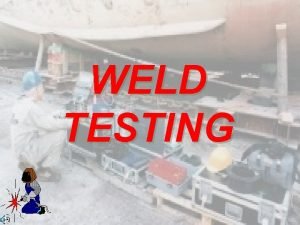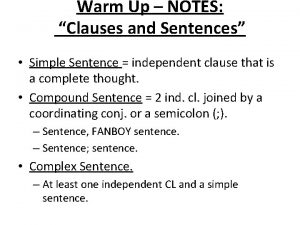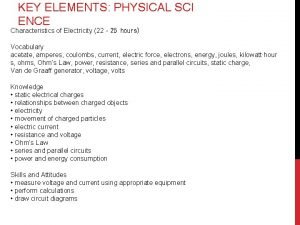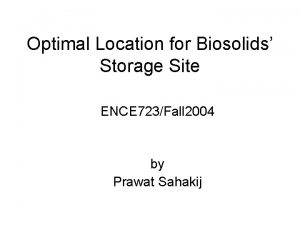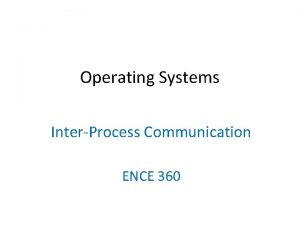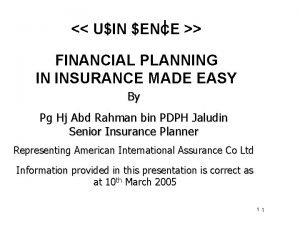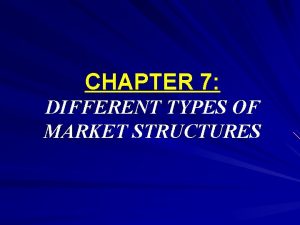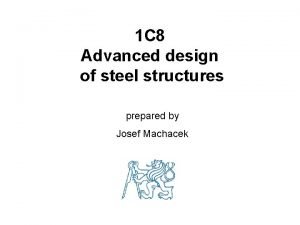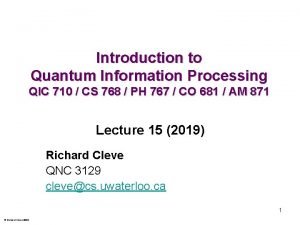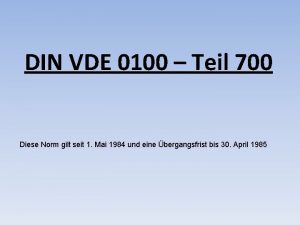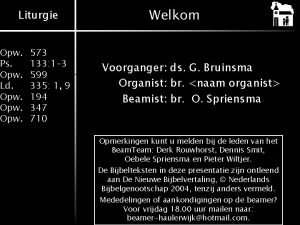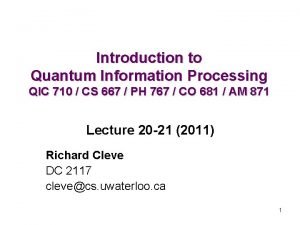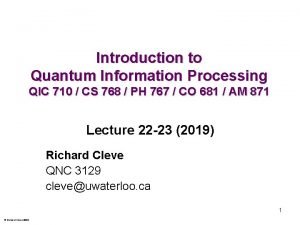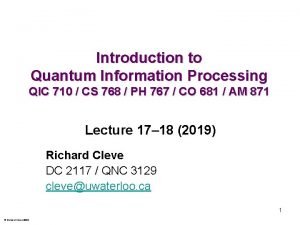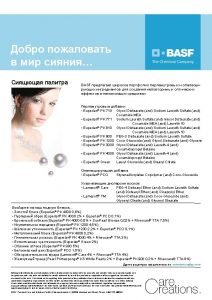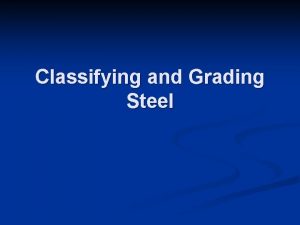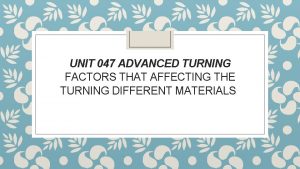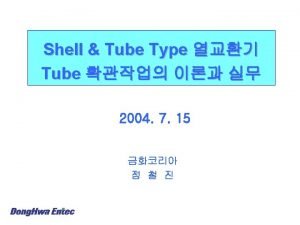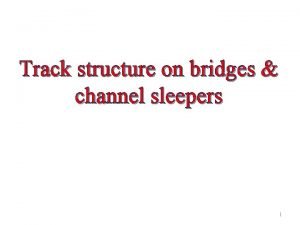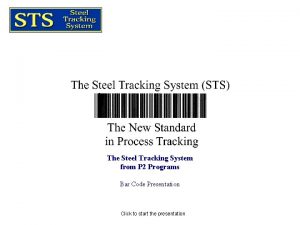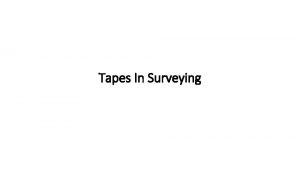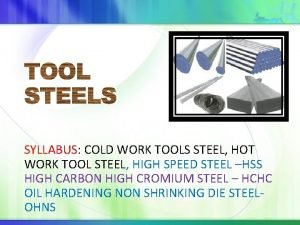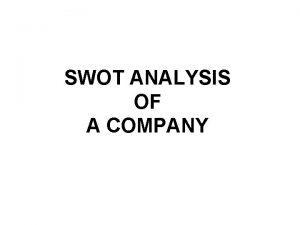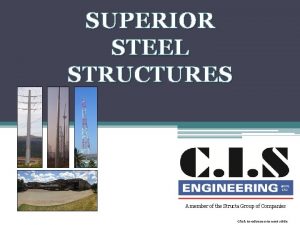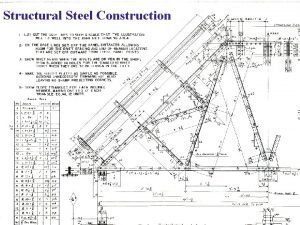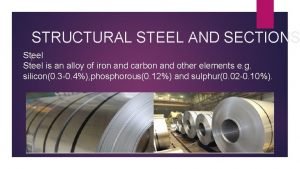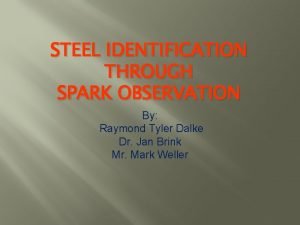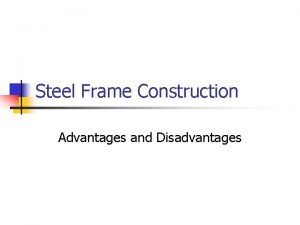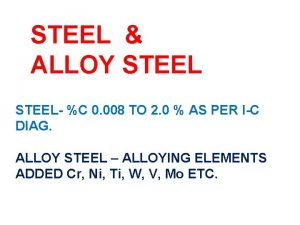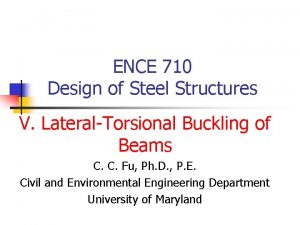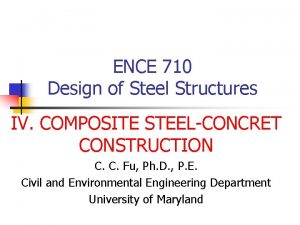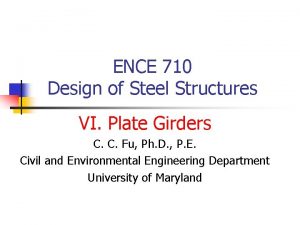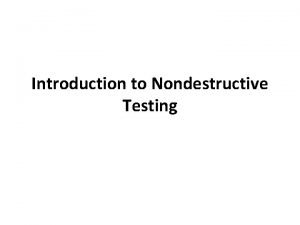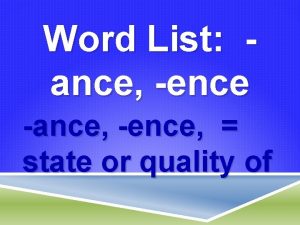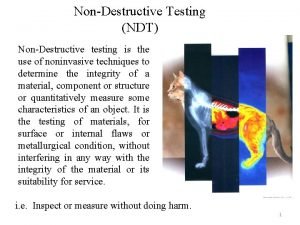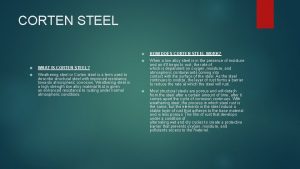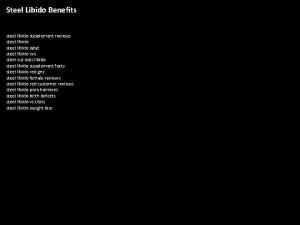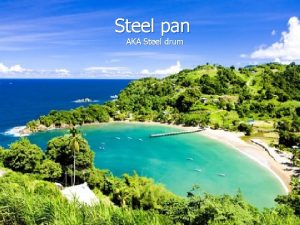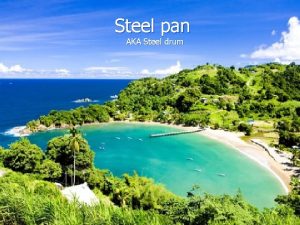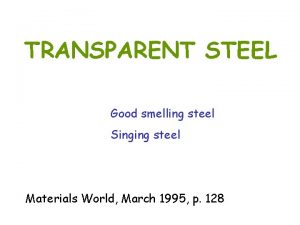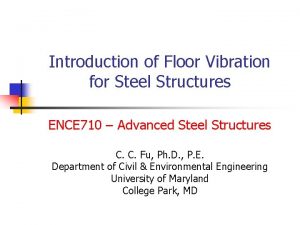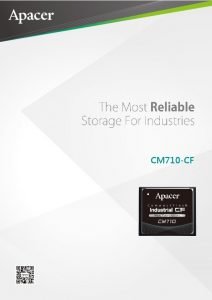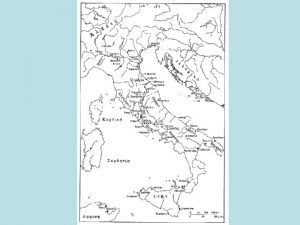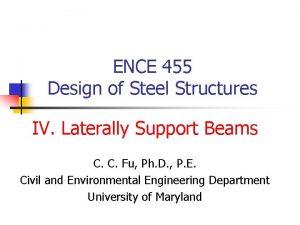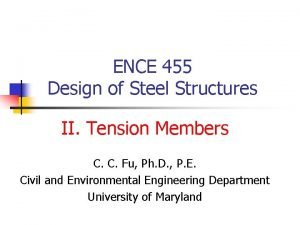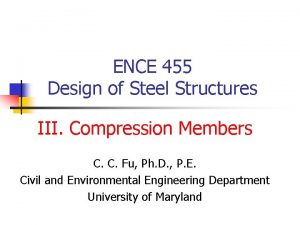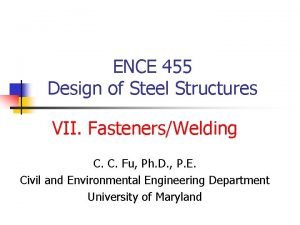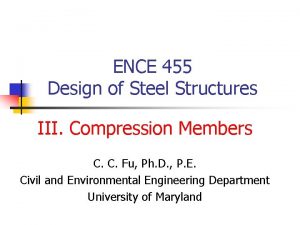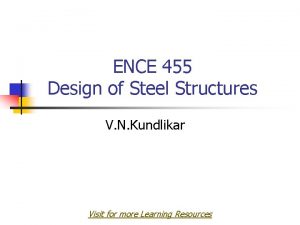Introduction of NonDestructive Test ENCE 710 Advanced Steel












































- Slides: 44

Introduction of Non-Destructive Test ENCE 710 – Advanced Steel Structures C. C. Fu, Ph. D. , P. E. Department of Civil & Environmental Engineering University of Maryland College Park, MD

Definition of NDT The use of noninvasive techniques to determine the integrity of a material, component or structure or quantitatively measure some characteristic of an object. i. e. Inspect or measure without doing harm. 2

What are Some Uses of NDE Methods? n Flaw Detection and Evaluation n Leak Detection n Location Determination n Dimensional Measurements n Structure and Microstructure Characterization n Estimation of Mechanical and Physical Properties n Stress (Strain) and Dynamic Response Measurements n Fluorescent penetrant indication Material Sorting and Chemical Composition Determination 3

When are NDE Methods Used? There are NDE application at almost any stage in the production or life cycle of a component n n n To assist in product development To screen or sort incoming materials To monitor, improve or control manufacturing processes To verify proper processing such as heat treating To verify proper assembly To inspect for in-service damage 4

Nondestructive Testing • Advantages – – – • Can test in-service structures Evaluate surface and internal conditions Cost efficient Disadvantages – – – Reliability (measurements are made indirectly) Qualitative Requires a skilled professional for interpretation of results 5

Destructive Testing • Advantages – – – • Reliable (direct measurements) Quantitative Directly relates to material properties Disadvantages – – Cannot test in-service structures Requires a model • – Costly & Time Consuming Multiple tests are sometimes required 6

Six Most Common NDT Methods • • • Visual Liquid Penetrant Magnetic Ultrasonic Eddy Current X-ray 7

Visual Inspection Most basic and common inspection method. Tools include fiberscopes, borescopes, magnifying glasses and mirrors. Portable video inspection unit with zoom allows inspection of large tanks and vessels, railroad tank cars, sewer lines. Robotic crawlers permit observation in hazardous or tight areas, such as air ducts, reactors, pipelines. 8

Liquid Penetrant Inspection • A liquid with high surface wetting characteristics is applied to the surface of the part and allowed time to seep into surface breaking defects. • The excess liquid is removed from the surface of the part. • A developer (powder) is applied to pull the trapped penetrant out the defect and spread it on the surface where it can be seen. • Visual inspection is the final step in the process. The penetrant used is often loaded with a fluorescent dye and the inspection is done under UV light to increase test sensitivity. 9

Liquid Penetration Process: n Clean surface n Apply liquid penetrant n Remove excess penetrant n Apply developer n Inspect n Post-cleaning 10

DYE PENETRANTS n These are an aid to visual inspection n Will only find surface defects n Use correct type 11

DYE PENETRANTS 12

DYE PENETRANTS n Types n n n Red Flouresant CAUTION n n Oil based Water washable 13

Dye Penetrant Test • Dye penetrant testing locates minute surface cracks and porosity • Dye types that may be used include: § Color contrast dye - which shows up under ordinary light § Fluorescent dye – which shows up under black light • The dye is normally applied by spraying it directly on the weld (AISC & NISD 2000) 14

Magnetic Particle Inspection The part is magnetized. Finely milled iron particles coated with a dye pigment are then applied to the specimen. These particles are attracted to magnetic flux leakage fields and will cluster to form an indication directly over the discontinuity. This indication can be visually detected under proper lighting conditions. 15

Magnetic Particle Process: n Magnetize surface n n n Discontinuities create a magnetic flux Sprinkle magnetic particles Inspect 16

Magnetic Particle Crack Indications 17

MAGNETIC PARTICLE n n n Mainly for surface defects Some sub surface defects can be found Only ferrous metal 18

Magnetic Particle Inspection • Magnetic particle inspection uses powdered magnetic particles to indicate defects in magnetic materials • A magnetic field is induced in the part • The magnetic powder is attracted to and outlines cracks within the material (AISC & NISD 2000) 19

Radiography X-ray Generator or Radioactive Source Creates Radiation High Electrical Potential The radiation used in radiography testing is a higher energy (shorter wavelength) version of the electromagnetic waves that we see as visible light. The radiation can come from an X-ray generator or a radioactive source. Electrons + - Radiation Penetrate the Sample Exposure Recording Device 20

Film Radiography The part is placed between the radiation source and a piece of film. The part will stop some of the radiation. Thicker and more dense area will stop more of the radiation. The film darkness (density) will vary with the amount of radiation reaching the film through X-ray film the test object. = less exposure = more exposure Top view of developed film 21

Radiographic Images 22

RADIOGRAPHIC X-RAY GAMMA RAY Electro magnetic radiation of short duration Both of these methods are a danger to health 23

Radiographic Inspection • Radiographic inspection, or X-ray, can also be used to detect flaws inside welds • Invisible rays penetrate the metal and reveal flaws on an x-ray film or fluorescent screen (above) • This is the most costly of the inspection methods (AISC & NISD 2000) 24

X- RAY 25

X- RAY 26

27

X-RAY VIEWER Pictures taken are viewed as negatives will only give flat image not in three dimensional darkened area must be used for viewing 28

Eddy Current Testing Coil's magnetic field Eddy currents Conductive material 29

Eddy Current Testing Eddy current testing is particularly well suited for detecting surface cracks but can also be used to make electrical conductivity and coating thickness measurements. Here a small surface probe is scanned over the part surface in an attempt to detect a crack. 30

Ultrasonic Inspection (Pulse-Echo) High frequency sound waves are introduced into a material and they are reflected back from surfaces or flaws. Reflected sound energy is displayed versus time, and f inspector can visualize a cross section of the specimen showing the depth of features that reflect sound. initial pulse crack echo back surface echo crack 0 2 4 6 8 Oscilloscope, or flaw detector screen 10 plate 31

Ultrasonic Imaging High resolution images can be produced by plotting signal strength or time-of-flight using a computer-controlled scanning system. Gray scale image produced using the sound reflected from the front surface of the coin Gray scale image produced using the sound reflected from the back surface of the coin (inspected from “heads” side) 32

ULTRASONIC TESTING This uses high pitched sound The sound will not pass through an air gap so bounces back and is picked up on a receiver The reader is a oscilloscope 33

ULTRA SONIC Device 34

35

Ultrasonic Inspection • Ultrasonic inspection can be used to detect flaws inside welds • High frequency sound waves are directed into the metal with a probe held at a specific angle • The flaws reflect some energy back to the probe • Flaws show up as indications on a screen (above) and are subject to interpretation by an inspector (AISC & NISD 2000) 36

Ultrasonic 37

Usage: Inspection of Raw Products Forgings, n Castings, n Extrusions, n etc. n 38

Usage: Inspection Following Secondary Processing Machining n Welding n Grinding n Heat treating n Plating n etc. n 39

Usage: Inspection For In-Service Damage Cracking n Corrosion n Erosion/Wear n Heat Damage n etc. n 40

Usage: Power Plant Inspection Periodically, power plants are shutdown for inspection. Inspectors feed eddy current probes into heat exchanger tubes to check for corrosion damage. Pipe with damage Probe Signals produced by various amounts of corrosion thinning. 41

Usage: Storage Tank Inspection Robotic crawlers use ultrasound to inspect the walls of large above ground tanks for signs of thinning due to corrosion. Cameras on long articulating arms are used to inspect underground storage tanks for damage. 42

Usage: Pressure Vessel Inspection The failure of a pressure vessel can result in the rapid release of a large amount of energy. To protect against this dangerous event, the tanks are inspected using radiography and ultrasonic testing. 43

Usage: Pipeline Inspection NDT is used to inspect pipelines to prevent leaks that could damage the environment. Visual inspection, radiography and electromagnetic testing are some of the NDT methods used. Remote visual inspection using a robotic crawler. Magnetic flux leakage inspection. This device, known as a pig, is placed in the pipeline and collects data on the condition of the pipe as it is pushed along by whatever is being transported. Radiography of weld joints. 44
 Introduction to nondestructive testing
Introduction to nondestructive testing Destructive and nondestructive testing of welds
Destructive and nondestructive testing of welds Aaawwubbis
Aaawwubbis Simple sentence notes
Simple sentence notes Comma causers
Comma causers Electric potential
Electric potential Ence storage
Ence storage Ence pipes
Ence pipes Easy for ence
Easy for ence Steel sws free cutting steel
Steel sws free cutting steel Advanced design of steel structures notes
Advanced design of steel structures notes Da 3161
Da 3161 Qic 710
Qic 710 Vde 0100 teil 710
Vde 0100 teil 710 699 en yakın onluğa yuvarlama
699 en yakın onluğa yuvarlama Ortec 710
Ortec 710 A gas has a pressure of 710 kpa at 227
A gas has a pressure of 710 kpa at 227 Equations word problems with variables on both sides
Equations word problems with variables on both sides Opwekking 573 tekst
Opwekking 573 tekst Qic 710
Qic 710 Qic 710
Qic 710 Qic 710
Qic 710 Ar 710-2-2
Ar 710-2-2 Euperlan pk 810
Euperlan pk 810 Spark test steel
Spark test steel Ah english dissertation
Ah english dissertation Advanced human trafficking #3271 test answers
Advanced human trafficking #3271 test answers Advanced fetal monitoring test answers
Advanced fetal monitoring test answers Intro paragraph outline
Intro paragraph outline Speed of sound through steel
Speed of sound through steel Steel stronger than iron
Steel stronger than iron Stainless steel code number
Stainless steel code number Bridge approach sleeper drawing
Bridge approach sleeper drawing Metal tracking system
Metal tracking system I stumbled in his hob-nailed wake,
I stumbled in his hob-nailed wake, Types of tapes in surveying
Types of tapes in surveying Hchc steel
Hchc steel Land rover swot analysis
Land rover swot analysis Superior steel structures
Superior steel structures Structural properties
Structural properties Compound fink truss
Compound fink truss Spark testing steel
Spark testing steel Advantages and disadvantages of frame relay
Advantages and disadvantages of frame relay Steel deck mf 50
Steel deck mf 50 Steel alloy
Steel alloy

